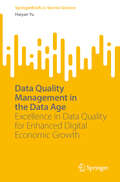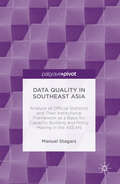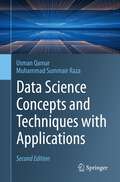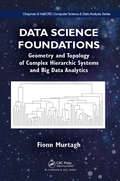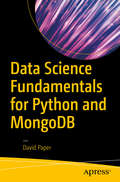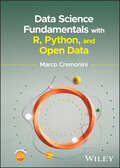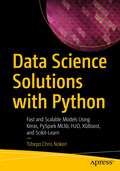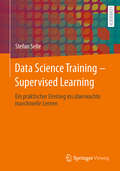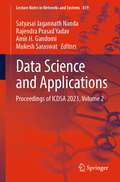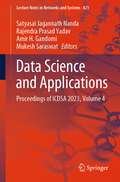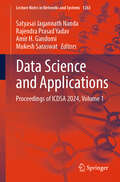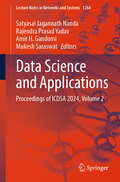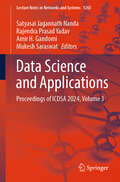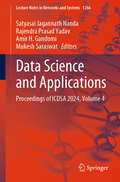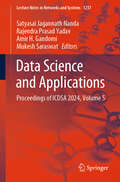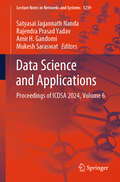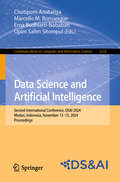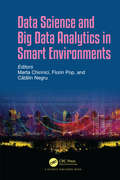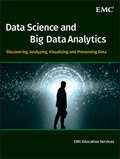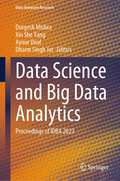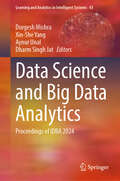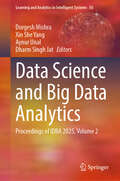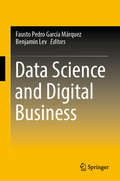- Table View
- List View
Data Quality Management in the Data Age: Excellence in Data Quality for Enhanced Digital Economic Growth (SpringerBriefs in Service Science)
by Haiyan YuThis book addresses data quality management for data markets, including foundational quality issues in modern data science. By clarifying the concept of data quality, its impact on real-world applications, and the challenges stemming from poor data quality, it will equip data scientists and engineers with advanced skills in data quality management, with a particular focus on applications within data markets. This will help them create an environment that encourages potential data sellers with high-quality data to join the market, ultimately leading to an improvement in overall data quality. High-quality data, as a novel factor of production, has assumed a pivotal role in driving digital economic development. The acquisition of such data is particularly important for contemporary decision-making models. Data markets facilitate the procurement of high-quality data and thereby enhance the data supply. Consequently, potential data sellers with high-quality data are incentivized to enter the market, an aspect that is particularly relevant in data-scarce domains such as personalized medicine and services. Data scientists have a pivotal role to play in both the intellectual vitality and the practical utility of high-quality data. Moreover, data quality control presents opportunities for data scientists to engage with less structured or ambiguous problems. The book will foster fruitful discussions on the contributions that various scientists and engineers can make to data quality and the further evolution of data markets.
Data Quality in Southeast Asia: Analysis of Official Statistics and Their Institutional Framework as a Basis for Capacity Building and Policy Making in the ASEAN
by Manuel StagarsThis book explores the reliability of official statisticaldata in the ASEAN (the Association of Southeast Asian Nations), and thebenefits of a better vocabulary to discuss the quality of publicly availabledata to address the needs of all users. It introduces a rigorous method todisaggregate and rate data quality into principal factors containing a total often dimensions, which serves as the basis for a discussion on the opportunitiesand challenges for data quality, capacity building programs and data policy in SoutheastAsia. Tools to standardize and monitor statistical capacity and data qualityare presented, as well as methods and data sources to analyse data quality. Thebook analyses data quality in Indonesia, Malaysia, Singapore, the Philippines,Thailand, Vietnam, Brunei, Laos, Cambodia, and Myanmar, before concluding withthoughts on Open Data and the ASEAN Economic Community (AEC).
Data Science Concepts and Techniques with Applications
by Muhammad Summair Raza Usman QamarThis textbook comprehensively covers both fundamental and advanced topics related to data science. Data science is an umbrella term that encompasses data analytics, data mining, machine learning, and several other related disciplines. The chapters of this book are organized into three parts: The first part (chapters 1 to 3) is a general introduction to data science. Starting from the basic concepts, the book will highlight the types of data, its use, its importance and issues that are normally faced in data analytics, followed by presentation of a wide range of applications and widely used techniques in data science. The second part, which has been updated and considerably extended compared to the first edition, is devoted to various techniques and tools applied in data science. Its chapters 4 to 10 detail data pre-processing, classification, clustering, text mining, deep learning, frequent pattern mining, and regression analysis. Eventually, the third part (chapters 11 and 12) present a brief introduction to Python and R, the two main data science programming languages, and shows in a completely new chapter practical data science in the WEKA (Waikato Environment for Knowledge Analysis), an open-source tool for performing different machine learning and data mining tasks. An appendix explaining the basic mathematical concepts of data science completes the book. This textbook is suitable for advanced undergraduate and graduate students as well as for industrial practitioners who carry out research in data science. They both will not only benefit from the comprehensive presentation of important topics, but also from the many application examples and the comprehensive list of further readings, which point to additional publications providing more in-depth research results or provide sources for a more detailed description of related topics. "This book delivers a systematic, carefully thoughtful material on Data Science." from the Foreword by Witold Pedrycz, U Alberta, Canada.
Data Science Foundations: Geometry and Topology of Complex Hierarchic Systems and Big Data Analytics (Chapman & Hall/CRC Computer Science & Data Analysis)
by Fionn Murtagh"Data Science Foundations is most welcome and, indeed, a piece of literature that the field is very much in need of…quite different from most data analytics texts which largely ignore foundational concepts and simply present a cookbook of methods…a very useful text and I would certainly use it in my teaching."- Mark Girolami, Warwick University Data Science encompasses the traditional disciplines of mathematics, statistics, data analysis, machine learning, and pattern recognition. This book is designed to provide a new framework for Data Science, based on a solid foundation in mathematics and computational science. It is written in an accessible style, for readers who are engaged with the subject but not necessarily experts in all aspects. It includes a wide range of case studies from diverse fields, and seeks to inspire and motivate the reader with respect to data, associated information, and derived knowledge.
Data Science Fundamentals for Python and MongoDB
by David PaperBuild the foundational data science skills necessary to work with and better understand complex data science algorithms. This example-driven book provides complete Python coding examples to complement and clarify data science concepts, and enrich the learning experience. Coding examples include visualizations whenever appropriate. The book is a necessary precursor to applying and implementing machine learning algorithms. The book is self-contained. All of the math, statistics, stochastic, and programming skills required to master the content are covered. In-depth knowledge of object-oriented programming isn’t required because complete examples are provided and explained.Data Science Fundamentals with Python and MongoDB is an excellent starting point for those interested in pursuing a career in data science. Like any science, the fundamentals of data science are a prerequisite to competency. Without proficiency in mathematics, statistics, data manipulation, and coding, the path to success is “rocky” at best. The coding examples in this book are concise, accurate, and complete, and perfectly complement the data science concepts introduced. What You'll LearnPrepare for a career in data scienceWork with complex data structures in PythonSimulate with Monte Carlo and Stochastic algorithmsApply linear algebra using vectors and matricesUtilize complex algorithms such as gradient descent and principal component analysisWrangle, cleanse, visualize, and problem solve with dataUse MongoDB and JSON to work with dataWho This Book Is ForThe novice yearning to break into the data science world, and the enthusiast looking to enrich, deepen, and develop data science skills through mastering the underlying fundamentals that are sometimes skipped over in the rush to be productive. Some knowledge of object-oriented programming will make learning easier.
Data Science Fundamentals with R, Python, and Open Data
by Marco CremoniniData Science Fundamentals with R, Python, and Open Data Introduction to essential concepts and techniques of the fundamentals of R and Python needed to start data science projects Organized with a strong focus on open data, Data Science Fundamentals with R, Python, and Open Data discusses concepts, techniques, tools, and first steps to carry out data science projects, with a focus on Python and RStudio, reflecting a clear industry trend emerging towards the integration of the two. The text examines intricacies and inconsistencies often found in real data, explaining how to recognize them and guiding readers through possible solutions, and enables readers to handle real data confidently and apply transformations to reorganize, indexing, aggregate, and elaborate. This book is full of reader interactivity, with a companion website hosting supplementary material including datasets used in the examples and complete running code (R scripts and Jupyter notebooks) of all examples. Exam-style questions are implemented and multiple choice questions to support the readers’ active learning. Each chapter presents one or more case studies. Written by a highly qualified academic, Data Science Fundamentals with R, Python, and Open Data discuss sample topics such as: Data organization and operations on data frames, covering reading CSV dataset and common errors, and slicing, creating, and deleting columns in R Logical conditions and row selection, covering selection of rows with logical condition and operations on dates, strings, and missing values Pivoting operations and wide form-long form transformations, indexing by groups with multiple variables, and indexing by group and aggregations Conditional statements and iterations, multicolumn functions and operations, data frame joins, and handling data in list/dictionary format Data Science Fundamentals with R, Python, and Open Data is a highly accessible learning resource for students from heterogeneous disciplines where Data Science and quantitative, computational methods are gaining popularity, along with hard sciences not closely related to computer science, and medical fields using stochastic and quantitative models.
Data Science Solutions with Python: Fast and Scalable Models Using Keras, PySpark MLlib, H2O, XGBoost, and Scikit-Learn
by Tshepo Chris NokeriApply supervised and unsupervised learning to solve practical and real-world big data problems. This book teaches you how to engineer features, optimize hyperparameters, train and test models, develop pipelines, and automate the machine learning (ML) process. The book covers an in-memory, distributed cluster computing framework known as PySpark, machine learning framework platforms known as scikit-learn, PySpark MLlib, H2O, and XGBoost, and a deep learning (DL) framework known as Keras. The book starts off presenting supervised and unsupervised ML and DL models, and then it examines big data frameworks along with ML and DL frameworks. Author Tshepo Chris Nokeri considers a parametric model known as the Generalized Linear Model and a survival regression model known as the Cox Proportional Hazards model along with Accelerated Failure Time (AFT). Also presented is a binary classification model (logistic regression) and an ensemble model (Gradient Boosted Trees). The book introduces DL and an artificial neural network known as the Multilayer Perceptron (MLP) classifier. A way of performing cluster analysis using the K-Means model is covered. Dimension reduction techniques such as Principal Components Analysis and Linear Discriminant Analysis are explored. And automated machine learning is unpacked. This book is for intermediate-level data scientists and machine learning engineers who want to learn how to apply key big data frameworks and ML and DL frameworks. You will need prior knowledge of the basics of statistics, Python programming, probability theories, and predictive analytics. What You Will LearnUnderstand widespread supervised and unsupervised learning, including key dimension reduction techniquesKnow the big data analytics layers such as data visualization, advanced statistics, predictive analytics, machine learning, and deep learningIntegrate big data frameworks with a hybrid of machine learning frameworks and deep learning frameworksDesign, build, test, and validate skilled machine models and deep learning modelsOptimize model performance using data transformation, regularization, outlier remedying, hyperparameter optimization, and data split ratio alteration Who This Book Is ForData scientists and machine learning engineers with basic knowledge and understanding of Python programming, probability theories, and predictive analytics
Data Science Training - Supervised Learning: Ein praktischer Einstieg ins überwachte maschinelle Lernen
by Stefan SelleDieses Lehrbuch erklärt auf narrative und direkte Weise die wichtigen Zusammenhänge zwischen Data Science, Künstlicher Intelligenz und anderen Disziplinen und Domänen wie Datenschutz und Ethik, mit Fokus auf überwachtes Lernen (Supervised Learning).Wir begleiten Anna und Karl während ihrer Traineephase in einer internationalen Versicherung. Schritt für Schritt reifen sie zu Data Scientists, indem sie sich intensiv mit der Titanic-Katastrophe auseinandersetzen. Anna kann Python programmieren, während Karl ein grafisches Werkzeug (KNIME Analytics Platform) benutzt. Bei ihren Untersuchungen stoßen sie auf interessante Fakten und Mythen. Mit Unterstützung von Max und Sophia verarbeiten sie historische Daten, um Vorhersagen zu erstellen (Predictive Analytics). Dabei benutzen sie Methoden und Algorithmen des maschinellen Lernens.Begleitende Zusatzmaterialien (KNIME Workflows, Jupyter Notebooks, Erklärvideos) stehen den Lernenden online zur Verfügung. Und wenn in diesemBuch Anna und Karl sich auf Themen des überwachten Lernens konzentrieren, werden wir künftig mit ihnen noch weitere Gebiete der Data Science entdecken.
Data Science and Analytics for SMEs: Consulting, Tools, Practical Use Cases
by Afolabi Ibukun TolulopeMaster the tricks and techniques of business analytics consulting, specifically applicable to small-to-medium businesses (SMEs). Written to help you hone your business analytics skills, this book applies data science techniques to help solve problems and improve upon many aspects of a business' operations. SMEs are looking for ways to use data science and analytics, and this need is becoming increasingly pressing with the ongoing digital revolution. The topics covered in the books will help to provide the knowledge leverage needed for implementing data science in small business. The demand of small business for data analytics are in conjunction with the growing number of freelance data science consulting opportunities; hence this book will provide insight on how to navigate this new terrain.This book uses a do-it-yourself approach to analytics and introduces tools that are easily available online and are non-programming based. Data science will allow SMEs to understand their customer loyalty, market segmentation, sales and revenue increase etc. more clearly. Data Science and Analytics for SMEs is particularly focused on small businesses and explores the analytics and data that can help them succeed further in their business. What You'll LearnCreate and measure the success of their analytics projectStart your business analytics consulting careerUse solutions taught in the book in practical uses cases and problems Who This Book Is ForBusiness analytics enthusiasts who are not particularly programming inclined, small business owners and data science consultants, data science and business students, and SME (small-to-medium enterprise) analysts
Data Science and Analytics with Python (Chapman & Hall/CRC Data Mining and Knowledge Discovery Series)
by Jesus Rogel-SalazarData Science and Analytics with Python is designed for practitioners in data science and data analytics in both academic and business environments. The aim is to present the reader with the main concepts used in data science using tools developed in Python, such as SciKit-learn, Pandas, Numpy, and others. The use of Python is of particular interest, given its recent popularity in the data science community. The book can be used by seasoned programmers and newcomers alike. The book is organized in a way that individual chapters are sufficiently independent from each other so that the reader is comfortable using the contents as a reference. The book discusses what data science and analytics are, from the point of view of the process and results obtained. Important features of Python are also covered, including a Python primer. The basic elements of machine learning, pattern recognition, and artificial intelligence that underpin the algorithms and implementations used in the rest of the book also appear in the first part of the book. Regression analysis using Python, clustering techniques, and classification algorithms are covered in the second part of the book. Hierarchical clustering, decision trees, and ensemble techniques are also explored, along with dimensionality reduction techniques and recommendation systems. The support vector machine algorithm and the Kernel trick are discussed in the last part of the book. About the Author Dr. Jesús Rogel-Salazar is a Lead Data scientist with experience in the field working for companies such as AKQA, IBM Data Science Studio, Dow Jones and others. He is a visiting researcher at the Department of Physics at Imperial College London, UK and a member of the School of Physics, Astronomy and Mathematics at the University of Hertfordshire, UK, He obtained his doctorate in physics at Imperial College London for work on quantum atom optics and ultra-cold matter. He has held a position as senior lecturer in mathematics as well as a consultant in the financial industry since 2006. He is the author of the book Essential Matlab and Octave, also published by CRC Press. His interests include mathematical modelling, data science, and optimization in a wide range of applications including optics, quantum mechanics, data journalism, and finance.
Data Science and Applications: Proceedings of ICDSA 2023, Volume 2 (Lecture Notes in Networks and Systems #819)
by Amir H. Gandomi Mukesh Saraswat Rajendra Prasad Yadav Satyasai Jagannath NandaThis book gathers outstanding papers presented at the International Conference on Data Science and Applications (ICDSA 2023), organized by Soft Computing Research Society (SCRS) and Malaviya National Institute of Technology Jaipur, India, from 14 to 15 July 2023. The book is divided into four volumes, and it covers theoretical and empirical developments in various areas of big data analytics, big data technologies, decision tree learning, wireless communication, wireless sensor networking, bioinformatics and systems, artificial neural networks, deep learning, genetic algorithms, data mining, fuzzy logic, optimization algorithms, image processing, computational intelligence in civil engineering, and creative computing.
Data Science and Applications: Proceedings of ICDSA 2023, Volume 4 (Lecture Notes in Networks and Systems #821)
by Amir H. Gandomi Mukesh Saraswat Rajendra Prasad Yadav Satyasai Jagannath NandaThis book gathers outstanding papers presented at the International Conference on Data Science and Applications (ICDSA 2023), organized by Soft Computing Research Society (SCRS) and Malaviya National Institute of Technology Jaipur, India, from 14 to 15 July 2023. The book is divided into four volumes, and it covers theoretical and empirical developments in various areas of big data analytics, big data technologies, decision tree learning, wireless communication, wireless sensor networking, bioinformatics and systems, artificial neural networks, deep learning, genetic algorithms, data mining, fuzzy logic, optimization algorithms, image processing, computational intelligence in civil engineering, and creative computing.
Data Science and Applications: Proceedings of ICDSA 2024, Volume 1 (Lecture Notes in Networks and Systems #1263)
by Amir H. Gandomi Mukesh Saraswat Rajendra Prasad Yadav Satyasai Jagannath NandaThis book gathers outstanding papers presented at the 5th International Conference on Data Science and Applications (ICDSA 2024), organized by Soft Computing Research Society (SCRS) and Malaviya National Institute of Technology Jaipur, India, from July 17 to 19, 2024. The book is divided into four volumes, and it covers theoretical and empirical developments in various areas of big data analytics, big data technologies, decision tree learning, wireless communication, wireless sensor networking, bioinformatics and systems, artificial neural networks, deep learning, genetic algorithms, data mining, fuzzy logic, optimization algorithms, image processing, computational intelligence in civil engineering, and creative computing.
Data Science and Applications: Proceedings of ICDSA 2024, Volume 2 (Lecture Notes in Networks and Systems #1264)
by Amir H. Gandomi Mukesh Saraswat Rajendra Prasad Yadav Satyasai Jagannath NandaThis book gathers outstanding papers presented at the 5th International Conference on Data Science and Applications (ICDSA 2024), organized by Soft Computing Research Society (SCRS) and Malaviya National Institute of Technology Jaipur, India, from 17 to 19 July 2024. The book is divided into four volumes, and it covers theoretical and empirical developments in various areas of big data analytics, big data technologies, decision tree learning, wireless communication, wireless sensor networking, bioinformatics and systems, artificial neural networks, deep learning, genetic algorithms, data mining, fuzzy logic, optimization algorithms, image processing, computational intelligence in civil engineering, and creative computing.
Data Science and Applications: Proceedings of ICDSA 2024, Volume 3 (Lecture Notes in Networks and Systems #1265)
by Amir H. Gandomi Mukesh Saraswat Rajendra Prasad Yadav Satyasai Jagannath NandaThis book gathers outstanding papers presented at the 5th International Conference on Data Science and Applications (ICDSA 2024), organized by Soft Computing Research Society (SCRS) and Malaviya National Institute of Technology Jaipur, India, from July 17 to 19, 2024. The book is divided into four volumes, and it covers theoretical and empirical developments in various areas of big data analytics, big data technologies, decision tree learning, wireless communication, wireless sensor networking, bioinformatics and systems, artificial neural networks, deep learning, genetic algorithms, data mining, fuzzy logic, optimization algorithms, image processing, computational intelligence in civil engineering, and creative computing.
Data Science and Applications: Proceedings of ICDSA 2024, Volume 4 (Lecture Notes in Networks and Systems #1266)
by Amir H. Gandomi Mukesh Saraswat Rajendra Prasad Yadav Satyasai Jagannath NandaThis book gathers outstanding papers presented at the 5th International Conference on Data Science and Applications (ICDSA 2024), organized by Soft Computing Research Society (SCRS) and Malaviya National Institute of Technology Jaipur, India, from July 17 to 19, 2024. The book is divided into four volumes, and it covers theoretical and empirical developments in various areas of big data analytics, big data technologies, decision tree learning, wireless communication, wireless sensor networking, bioinformatics and systems, artificial neural networks, deep learning, genetic algorithms, data mining, fuzzy logic, optimization algorithms, image processing, computational intelligence in civil engineering, and creative computing.
Data Science and Applications: Proceedings of ICDSA 2024, Volume 5 (Lecture Notes in Networks and Systems #1237)
by Amir H. Gandomi Mukesh Saraswat Rajendra Prasad Yadav Satyasai Jagannath NandaThis book gathers outstanding papers presented at the 5th International Conference on Data Science and Applications (ICDSA 2024), organized by Soft Computing Research Society (SCRS) and Malaviya National Institute of Technology Jaipur, India, from 17 to 19 July 2024. The book is divided into four volumes, and it covers theoretical and empirical developments in various areas of big data analytics, big data technologies, decision tree learning, wireless communication, wireless sensor networking, bioinformatics and systems, artificial neural networks, deep learning, genetic algorithms, data mining, fuzzy logic, optimization algorithms, image processing, computational intelligence in civil engineering, and creative computing.
Data Science and Applications: Proceedings of ICDSA 2024, Volume 6 (Lecture Notes in Networks and Systems #1239)
by Amir H. Gandomi Mukesh Saraswat Rajendra Prasad Yadav Satyasai Jagannath NandaThis book gathers outstanding papers presented at the 5th International Conference on Data Science and Applications (ICDSA 2024), organized by Soft Computing Research Society (SCRS) and Malaviya National Institute of Technology Jaipur, India, from 17 to 19 July 2024. The book is divided into four volumes, and it covers theoretical and empirical developments in various areas of big data analytics, big data technologies, decision tree learning, wireless communication, wireless sensor networking, bioinformatics and systems, artificial neural networks, deep learning, genetic algorithms, data mining, fuzzy logic, optimization algorithms, image processing, computational intelligence in civil engineering, and creative computing.
Data Science and Artificial Intelligence: Second International Conference, DSAI 2024, Medan, Indonesia, November 13–15, 2024, Proceedings (Communications in Computer and Information Science #2318)
by Marcello M. Bonsangue Chutiporn Anutariya Erna Budhiarti-Nababan Opim Salim SitompulThis book constitutes the proceedings of the Second refereed proceedings of the Second International Conference on Data Science and Artificial Intelligence, DSAI 2024, held in Medan, Indonesia, during November 13–15, 2024. The 18 full papers, 2 short papers and 3 invited talks were included in this book were carefully reviewed and selected from 69 submissions. They are organized in the following topical sections: Keynote Presentations; Natural and Sign Language Processing; Applications of Data Science and Artificial Intelligence; Affective Computing and AI Games; Embedded AI and Applications; Data Science; AI and Healthcare.
Data Science and Big Data Analytics in Smart Environments
by Marta Chinnici; Florin Pop; Cătălin NegruMost applications generate large datasets, like social networking and social influence programs, smart cities applications, smart house environments, Cloud applications, public web sites, scientific experiments and simulations, data warehouse, monitoring platforms, and e-government services. Data grows rapidly, since applications produce continuously increasing volumes of both unstructured and structured data. Large-scale interconnected systems aim to aggregate and efficiently exploit the power of widely distributed resources. In this context, major solutions for scalability, mobility, reliability, fault tolerance and security are required to achieve high performance and to create a smart environment. The impact on data processing, transfer and storage is the need to re-evaluate the approaches and solutions to better answer the user needs. A variety of solutions for specific applications and platforms exist so a thorough and systematic analysis of existing solutions for data science, data analytics, methods and algorithms used in Big Data processing and storage environments is significant in designing and implementing a smart environment.Fundamental issues pertaining to smart environments (smart cities, ambient assisted leaving, smart houses, green houses, cyber physical systems, etc.) are reviewed. Most of the current efforts still do not adequately address the heterogeneity of different distributed systems, the interoperability between them, and the systems resilience. This book will primarily encompass practical approaches that promote research in all aspects of data processing, data analytics, data processing in different type of systems: Cluster Computing, Grid Computing, Peer-to-Peer, Cloud/Edge/Fog Computing, all involving elements of heterogeneity, having a large variety of tools and software to manage them. The main role of resource management techniques in this domain is to create the suitable frameworks for development of applications and deployment in smart environments, with respect to high performance. The book focuses on topics covering algorithms, architectures, management models, high performance computing techniques and large-scale distributed systems.
Data Science and Big Data Analytics: Discovering, Analyzing, Visualizing and Presenting Data
by Emc Education ServicesData Science and Big Data Analytics is about harnessing the power of data for new insights. The book covers the breadth of activities and methods and tools that Data Scientists use. The content focuses on concepts, principles and practical applications that are applicable to any industry and technology environment, and the learning is supported and explained with examples that you can replicate using open-source software.This book will help you:Become a contributor on a data science teamDeploy a structured lifecycle approach to data analytics problemsApply appropriate analytic techniques and tools to analyzing big dataLearn how to tell a compelling story with data to drive business actionPrepare for EMC Proven Professional Data Science Certification
Data Science and Big Data Analytics: Proceedings of IDBA 2023 (Data-Intensive Research)
by Aynur Unal Dharm Singh Jat Durgesh Mishra Xin She YangThis book features high-quality research papers presented at the Third International Conference on Data Science and Big Data Analytics (IDBA 2023), organized by Sri Aurobindo Institute of Technology, Indore, India, in association with ACM and IEEE Computer Society in hybrid mode during June 16–17, 2023. This book discusses the topics such as data science, artificial intelligence, machine learning, quantum computing, big data and cloud security, computation security, big data security, information security, forecasting, data analytics, mathematics for data science, graph theory and application in data science, data visualization, computer vision, and analytics for social networks.
Data Science and Big Data Analytics: Proceedings of IDBA 2024 (Learning and Analytics in Intelligent Systems #43)
by Xin-She Yang Aynur Unal Dharm Singh Jat Durgesh MishraThis book features high-quality research papers presented at the Fourth International Conference on Data Science and Big Data Analytics (IDBA 2024), organized by Symbiosis University of Applied Sciences, Indore, India, in association with ACM and IEEE Computer Society in hybrid mode during July 12–13, 2024. This book discusses the topics such as data science, artificial intelligence, machine learning, quantum computing, big data and cloud security, computation security, big data security, information security, forecasting, data analytics, mathematics for data science, graph theory and application in data science, data visualization, computer vision, and analytics for social networks.
Data Science and Big Data Analytics: Proceedings of IDBA 2025, Volume 2 (Learning and Analytics in Intelligent Systems #56)
by Aynur Unal Dharm Singh Jat Durgesh Mishra Xin She YangThis book features high-quality research papers presented at the Fifth International Conference on Data Science and Big Data Analytics (IDBA 2025), organized by Symbiosis University of Applied Sciences, Indore, India, in association with ACM and IEEE Computer Society in hybrid mode during June 27–28, 2025. This book discusses topics such as data science, artificial intelligence, machine learning, quantum computing, big data and cloud security, computation security, big data security, information security, forecasting, data analytics, mathematics for data science, graph theory and application in data science, data visualization, computer vision, and analytics for social networks.
Data Science and Digital Business
by Fausto Pedro García Márquez Benjamin LevThis book combines the analytic principles of digital business and data science with business practice and big data. The interdisciplinary, contributed volume provides an interface between the main disciplines of engineering and technology and business administration. Written for managers, engineers and researchers who want to understand big data and develop new skills that are necessary in the digital business, it not only discusses the latest research, but also presents case studies demonstrating the successful application of data in the digital business.
